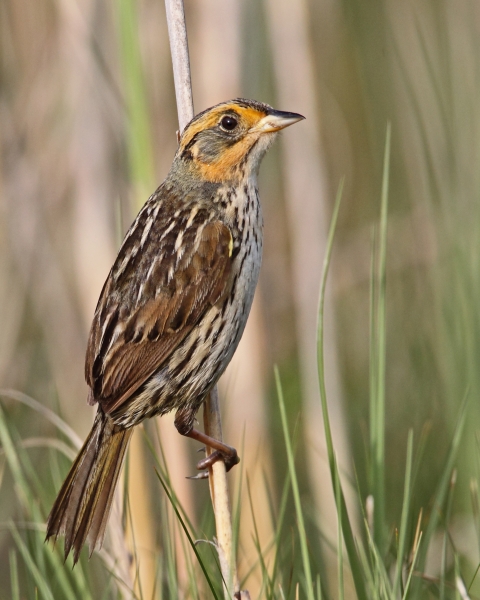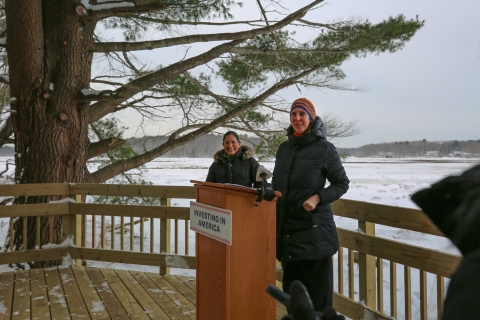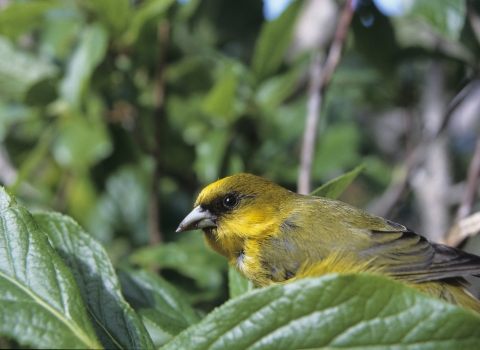“Climate impacts, including rising sea levels and shifting storm patterns, are transforming coastal landscapes and undermining the resilience of communities and ecosystems.”
- Fifth National Climate Assessment, November 2023
Coastal salt marshes are on the frontlines of climate change climate change
Climate change includes both global warming driven by human-induced emissions of greenhouse gases and the resulting large-scale shifts in weather patterns. Though there have been previous periods of climatic change, since the mid-20th century humans have had an unprecedented impact on Earth's climate system and caused change on a global scale.
Learn more about climate change , facing sea-level rise and storm surge head on. This precious ecosystem, which serves as a buffer during weather events and provides important habitat for many species, is impeded by past and present human development that has weakened it in many places and often blocks its natural movement inland.
Because of these tremendous challenges, conservation projects aimed at restoring marshes and preserving space where marshes can eventually retreat inland are receiving critical funding through the Bipartisan Infrastructure Law Bipartisan Infrastructure Law
The Bipartisan Infrastructure Law (BIL) is a once-in-a-generation investment in the nation’s infrastructure and economic competitiveness. We were directly appropriated $455 million over five years in BIL funds for programs related to the President’s America the Beautiful initiative.
Learn more about Bipartisan Infrastructure Law .
Recognizing the enormous value of salt marshes, the Department of the Interior and U.S. Fish and Wildlife Service, with funding support from the Bipartisan Infrastructure Law, launched the Salt Marsh Keystone Initiative in January 2024. Partnering with others, we are leveraging resources and expertise to help make informed, efficient use of funds to restore this valuable habitat, creating a more resilient coastline to address climate change.
Where land meets sea
Salt marshes are found in tidal areas near the coast, where freshwater mixes with saltwater.
Learn more about salt marsh along the Northeast coast and winter in the warmer Southeast.
Salt marshes exist where land and sea meet. Daily tides refresh the landscape with ocean waters and support wildlife and plants adapted to these dynamic conditions.
Saltmarsh sparrows rely on their namesake habitat for survival, nesting only in the salt marshes of the Northeast and spending their winters south to Florida. Their numbers are declining at an alarming rate as rising seas inundate nests. Without our help, they could face extinction.
Other bird species — the threatened eastern black rail, at-risk American oystercatcher and many species of waterfowl, including the American black duck — rely on these areas for habitat as well.
Beyond birds, salt marshes are home to many other high priority species, from West Indian manatees and loggerhead sea turtles to Atlantic sturgeon. The threatened, and secretive, eastern black rail is the focus of much of the Service’s habitat restoration work at Merritt Island, Ernest F. Hollings ACE Basin and Alligator River national wildlife refuges, while conservation in support of saltmarsh sparrow is a major focus at Rachel Carson, Great Bay and Blackwater national wildlife refuges.
Salt marshes are also home to many wildlife species that people and businesses rely upon. They serve as critical nurseries for healthy populations of commercially valuable fish and shellfish. Their benefit to people doesn’t end there; they also absorb storm surge like a sponge, protecting nearby property and natural areas during severe weather.
Sadly, centuries of human alterations have greatly reduced the extent and function of salt marshes. And now, rising seas are creeping up on them. Where there’s room, they can “migrate” inland, but often the best strategy to support salt marshes is through restoration.
Team salt marsh
Climate change is the existential threat of our time, and salt marshes are an ally in the fight against a rising tide. They not only buffer coastal communities — and save billions of dollars in infrastructure — but also store a tremendous amount of carbon in their soils. These “blue carbon” superheroes remove carbon from the atmosphere at a rate up to 50 times faster than terrestrial forests.
However, once salt marshes are degraded or lost, their ability to protect our communities and planet from the impacts of climate change no longer exists. In the Southeast, roughly one million acres of salt marsh blanket the Atlantic coasts of Florida, Georgia and the Carolinas. Yet, a full one-third of the coastal wetlands could be lost to sea level rise by 2060, according to the National Oceanic and Atmospheric Administration.
A proven game plan
In October 2012, Hurricane Sandy pummeled the Northeast with high winds, heavy rain and flooding. While coastal wetlands prevented an estimated $625 million in property damage during the storm, Sandy taught us that a coast challenged by human development and rising seas is not fully equipped to endure the impacts of climate change.
In the wake of Sandy, the U.S. Fish and Wildlife Service invested $103 million in nature-based solutions to increase resilience on the East Coast. Through salt marsh restoration, dam removals and living shorelines, we enhanced water quality, reduced coastal erosion and storm damage, and increased public safety, while creating jobs and supporting businesses.
As the oceans warm, hurricanes get more intense, and the rate of sea level rise increases, these proven nature-based solutions bolster our fragile marshes. Planning for the future, the Service and our partners have spent tens of millions of dollars building living shorelines, acquiring land for marsh migration, and planting sea grasses and oyster reefs to slow the advancing Atlantic Ocean.
Federal funding fuels conservation efforts
Through President Biden’s Investing in America Agenda, which focuses funds for conservation efforts aimed at climate resilience across the country, the Service is teaming with multiple partners — including federal, Tribal, state and local governments, nonprofit organizations, industry, landowners and academic institutions — to understand, sustain and improve coastal habitats.
With $3 million in fiscal year 2024, the Service is set to improve salt marsh health through multiple projects in New Hampshire and Rhode Island. Alongside partners, we’ll restore more than 1,000 acres of tidal salt marsh, creating habitat for the saltmarsh sparrow and many other species, enhancing recreational and commercial fisheries, increasing habitat connectivity, and strengthening the coast against sea-level rise and storm surge. Additional federal funding of more than $900,000 has been allocated to support salt marsh restoration efforts in Maryland and Virginia.
The Service is a member of the South Atlantic Salt Marsh Initiative — a regional partnership of local, state and federal agencies, including the Department of Defense, as well as nonprofits and community groups. The goal is to ensure survival of coastal wetlands with a heavy dose of nature-based solutions: oyster reef restorations, dredge spoil placements, vegetation plantings and more. Critically, the initiative focuses on marsh migration corridors and removal or retrofitting of barriers that impede movement of salt marshes under siege from rising seas.
And, in all that the Service does, the interests of local communities are paramount. Saving salt marshes keeps the rising ocean at bay — to the benefit of anglers, birders, kayakers, innkeepers, shop owners and, importantly, descendants of the enslaved peoples who live in the coastal enclaves and sea islands that dot the Southeast’s coast.
In it to win it
The power of coastal marshes to protect homes, roads and bridges from severe weather is clear; their significance to wildlife is undeniable; and their ability to slow the impacts of climate change through storing carbon is important.
We couldn’t ask for better allies in addressing the impacts of climate change, and buffering our communities from its effects, than the country’s salt marshes. With additional opportunities provided through the Bipartisan Infrastructure Law, we have the necessary resources for the fight to improve salt marsh health up and down the Atlantic seaboard, boosting community safety, wildlife habitat and climate resilience.








